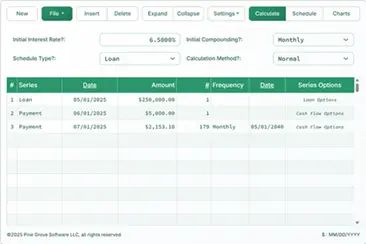How Much to Save or Invest to Reach a Goal
To set your preferred currency and date format, click the “$ : MM/DD/YYYY” link in the lower right corner of any calculator.
A Step-by-Step Tutorial
Tutorial 17
This tutorial explains how to use the Ultimate Financial Calculator to answer the question: “How much do I need to invest each period to reach my goal?”
Time value of money calculations involve five core variables:
- Starting amount — also called present value, or PV
- Cash flow amount — payment, savings, or investment
- Ending amount — also called future value, or FV
- Interest rate
- Term — the time between PV and FV, or the number of cash flows
The Ultimate Financial Calculator can solve for any of these five variables. This tutorial focuses on calculating the cash flow amount. These instructions apply to any cash flow type — payment, savings, or investment.
All users should complete the more detailed first tutorial to understand the UFC's core concepts and settings.
Background: Here is a practical example. You want to pay cash for your next car. The estimated price is $32,600. You plan to purchase the car four years from now. You currently have $4,000 saved.
To create a cash flow schedule that achieves this goal, and where the required periodic investment is not yet known, follow these steps:
- Set Schedule Type to Savings.
- Or click to clear any existing entries.
- Click , then select . Set Rounding to Open balance — no adjustment.
- In the header section, make the following selections:
- Select Normal for Calculation Method.
- Set Initial Compounding to Daily.
- Enter 4.5 for Initial Interest Rate.
- In row 1 of the cash‑flow input area, create a “Deposit” series.
- Set the “Date” to July 16, 2024.
- Set the “Amount” to $4,000.00 (this is the current amount saved).
- Set the “# Periods” to 1.
- Note: Since the number of periods is 1, you will not be able to set a frequency. If you enter a frequency, it will be cleared when you leave the row.
- Click row 2 of the cash‑flow input area. Select Deposit for the “Series”.
- Set the “Date” to August 1, 2024.
- Set the “Amount” to Unknown by typing U.
- Use the Tab key to move to “# Periods”. Set it to 48.
- Set the “Frequency” to Monthly.
- Create a third series. Set the “Series” to Withdrawal.
- Set the “Date” to August 1, 2028.
- Set the “Amount” to $32,600.00.
- Set the “# Periods” to 1.
- Your calculator should now look like this (Fig. 1):

- Click . The result is $526.67.
- Invest $526 every month over a 4-year period at 4.5% to pay cash for the car. See Fig. 2.

- To view a detailed cash flow schedule showing interest earned on the monthly deposits, click .
- Total deposits: $29,280.16. See Fig. 3.
- Total interest earned: $3,320.05.

This example illustrates how the time value of money can benefit the consumer. Does the car cost $32,600? Yes. However, based on deposits, you paid only $29,280. The remaining amount was covered by investment earnings. The difference would be even greater if you financed the car over 4 years at 4.5% interest. In that case, you would pay more than $3,000 in interest for the convenience of financing.
*This is a simplified example. It does not include taxes or evaluate whether your investments could earn more than the loan interest rate. If so, financing the purchase might be more advantageous than paying in full with cash.
Back to the Ultimate Financial Calculator.
